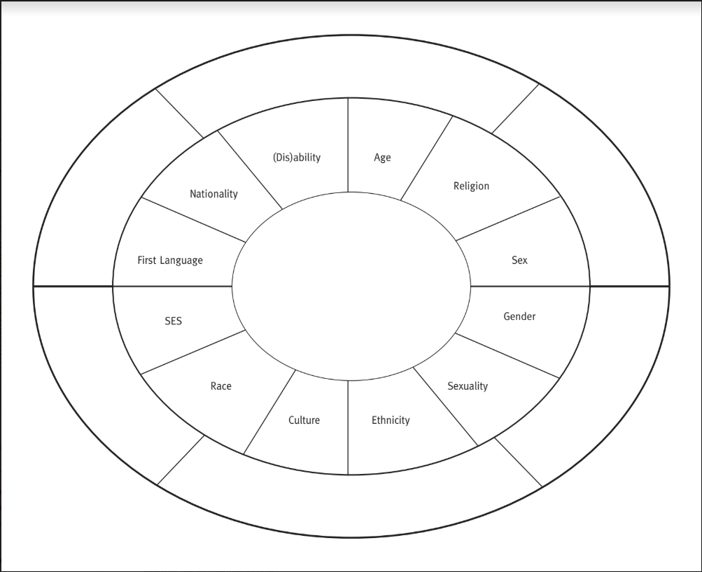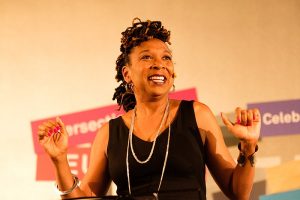The Social Construction of Difference
Elizabeth B. Pearce
Social Identities
Families are made up of individuals and each individual possesses a unique social identity. A social identity consists of the combination of social characteristics, roles, and group memberships with which a person identifies. Let’s break down each of those aspects of social identity.
- Social characteristics can be biologically determined and/or socially constructed. Sex, gender, race, ethnicity, ability, age, sexuality, nationality, first language, and religion are all social characteristics.
- Roles indicate the behaviors and patterns utilized, such as parent, partner, sibling, employee, employer, etc.
- Group memberships are often related to the above characteristics (e.g. a place of worship) and roles (e.g. a moms’ group), but could be more specialized as well, such as being a twin, or a singer, or part of an emotional support group.


The above Social Identity Wheel includes some common categories for social characteristics in the middle oval. When it comes to social identity, each of us gets to determine our own. That means we determine which of our social characteristics, roles, and group memberships are most important to our own identities. While each of us gets to determine our own social identity, it is important to note that others may identify us differently than we identify ourselves. Our most notable physical aspects may signal something different than our personal lived experience.
For example, in this video about cultural humility (which will be defined and discussed in the next chapter), Dr. Melanie Tervalon describes her identity as an African American woman, the difference between how she sees herself and how others see her, and the right that each of us has to our own social identity.
The founders of Mixed in America (MIA), whose mission is to empower the Mixed community and heal Mixed identity, are two multiracial activists, Jazmine Jarvis and Meagan Kimberly Smith. This is what they had to say about social identity on Taylor Nolan’s podcast, Let’s Talk About It: “We wanna put the power back in the person’s hands, so that they can express in a way that makes them feel authentic.”
The Social Construction of Difference
Social identities can help us understand the social construction of difference. In the process of forming our own social identities, we connect most easily to people who share the same group membership(s) that we do. According to the Social Identity Theory formulated by Henri Tajfel, we see people who are members of different groups as “others.”[1] In general, we tend to be drawn to others who are more similar to ourselves, whether by appearance or related to other social characteristics, such as age, ability, or sex. This, in combination with the likelihood of overestimating the similarities within groups and the differences between groups, contributes to the social construction of difference.
THE SOCIAL CONSTRUCTION OF RACE

The social construction of race deserves a special mention, since there is a broadly held public assumption that there are significant biological and genetic differences between human beings based on “race” (meaning observable physical differences such as skin color). In actuality, race is a social construct rather than a biological reality. Scientists state that while genetic diversity exists, it does not divide along the racial lines that many humans notice.[2] In fact, members of the human “race” (all humans) share 99.9 % of their genes.[3] Ancestry and geography likely influence which genes get “turned on” and expressed. What makes our understanding of race complicated is that we have behaved for centuries as if there is a biological difference. Because there has been a longstanding discriminatory practice against people of color, there are multiple impacts today.[4]
The reasons for doubting the biological basis for racial categories suggest that race is more of a social category than a biological one. Another way to say this is that race is a social construction, a concept that has no objective reality but rather is what people decide it is. In this view, race has no real existence other than what and how people think of it.

This understanding of race is reflected in the problems of placing people with multiracial backgrounds into any one racial category. Would you consider former President Obama, White, Black, or multiracial? He had one Black parent and one White parent. As another example, the well-known golfer Tiger Woods was typically called an African American by the news media when he burst onto the golfing scene in the late 1990s, but in fact his ancestry is one-half Asian (divided evenly between Chinese and Thai), one-quarter White, one-eighth Native American, and only one-eighth African American.[5]
Historical examples of attempts to place people in racial categories further underscore the social constructionism of race. In the South during the time of slavery, the skin tone of the enslaved lightened over the years as babies were born from the union, often in the form of rape, of slave owners and other Whites with enslaved people. As it became difficult to tell who was “Black” and who was not, many court battles over people’s racial identity occurred. People who were accused of having Black ancestry would go to court to prove they were White in order to avoid enslavement or other problems. .[6] Litigation over race continued long past the days of slavery. In a relatively recent example, Susie Guillory Phipps sued the Louisiana Bureau of Vital Records in the early 1980s to change her official race to White. Phipps was descended from a slave owner and an enslaved person and thereafter had only White ancestors. Despite this fact, she was called “Black” on her birth certificate because of a state law, echoing the “one-drop rule,” that designated people as Black if their ancestry was at least 1/32 Black (meaning one of their great-great-great grandparents was Black). Phipps had always thought of herself as White and was surprised after seeing a copy of her birth certificate to discover she was officially Black because she had one Black ancestor about 150 years earlier. She lost her case, and the U.S. Supreme Court later refused to review it.[7]
Social Construction of Other Social Identities, including Gender
It is important to note that the social construction of gender is another widely accepted concept. In other words, the differences that we attribute to the biological designation of female, male, or intersex are actually predominantly constructed by our societal beliefs, and not by biology. The recent broadening of gender identity and expression clearly demonstrates this concept.
Other identities are also constructed via societal agreement. Sexuality, ability, religion, ethnicity, age, and other identities may contain some physical parameters, and certainly contain meaning to the individuals that possess them. Critical to our study of families, however, is the understanding that society creates and reinforces social construction of these characteristics and those constructions favor some groups, discriminate against others, and generally impact the lives of families.
Intersectionality

Articulated by legal scholar Kimberlé Crenshaw (1991), the concept of intersectionality identifies a mode of analysis integral to women, gender, and sexuality studies. Within intersectional frameworks, race, class, gender, sexuality, age, ability, and other aspects of identity are experienced simultaneously and the meanings of different aspects of identity are shaped by one another. In other words, notions of gender and the way a person’s gender is interpreted by others are always impacted by notions of race and the way that person’s race is interpreted. For example, a person is never received as just a woman, but how that person is racialized impacts how the person is received as a woman. So, notions of blackness, brownness, and whiteness always influence gendered experience, and there is no experience of gender that is outside of an experience of race. In addition to race, gendered experience is also shaped by age, sexuality, class, and ability; likewise, the experience of race is impacted by gender, age, class, sexuality, and ability.

Understanding intersectionality requires a particular way of thinking. It is different than the ways in which many people imagine identities operate. An intersectional analysis of identity is distinct from single-determinant identity models which presume that one aspect of identity (say, gender) dictates one’s access to or disenfranchisement from power. An example of this idea is the concept of “global sisterhood,” or the idea that all women across the globe share some basic common political interests, concerns, and needs.[8] If women in different locations did share common interests, it would make sense for them to unite on the basis of gender to fight for social changes on a global scale. Unfortunately, if the analysis of social problems stops at gender, what is missed is an attention to how various cultural contexts shaped by race, religion, and access to resources may actually place some women’s needs at cross-purposes to other women’s needs. Therefore, this approach obscures the fact that women in different social and geographic locations face different problems. Although many White, middle-class women activists of the mid-20th century US fought for freedom to work and legal parity with men, this was not the major problem for women of color or working-class White women who had already been actively participating in the US labor market as domestic workers, factory workers, and enslaved laborers since early US colonial settlement. Campaigns for women’s equal legal rights and access to the labor market at the international level are shaped by the experience and concerns of White American women, while women of the Global South, in particular, may have more pressing concerns: access to clean water, access to adequate health care, and safety from the physical and psychological harms of living in tyrannical, war-torn, or economically impoverished nations.
“Gender” is too often used simply and erroneously to mean “White women,” while “race” too often connotes “Black men.” An intersectional perspective examines how identities are related to each other in our own experiences and how the social structures of race, class, gender, sexuality, age, and ability intersect for everyone. As opposed to single-determinant and additive models of identity, an intersectional approach develops a more sophisticated understanding of the world and how individuals in differently situated social groups experience differential access to both material and symbolic resources such as privilege.
Licenses and Attributions
Open Content, Shared Previously
“Social Construction of Race” is adapted from “The Meaning of Race and Ethnicity” in Sociology: Understanding and Changing the Social World by Anonymous. License: CC BY-NC-SA 4.0. Adaptation: rewritten for clarity.
“Intersectionality” is adapted from Introduction to Women, Gender, Sexuality Studies by Miliann Kang, Donovan Lessard, and Laura Heston, UMass Amherst Libraries. License: CC BY 4.0. Adaptation: switched images.
Figure 1.13. Photo by Jonathan Borba. License: Unsplash License.
Figure 1.14. Photo by Clay Banks. License: Unsplash License.
Figure 1.15. “Barack Obama on the Primary” by Steve Jurvetson. License: CC BY 2.0.
Figure 1.16. “Kimberlé Crenshaw” by Mohamed Badarne. License: CC BY-SA 4.0.
Figure 1.17. Photo by Liam Seskis. License: Unsplash License.
Open Content, Original
Figure 1.12. “Social identity wheel” by Liz Pearce. License: CC BY 4.0.
All Rights Reserved Content
“Cultural Humility Edited” (c) W.B. Jordan. License Terms: Standard YouTube license.
- McLeod, S. (2019). Social identity theory. Simply Psychology. https://www.simplypsychology.org/social-identity-theory.html ↵
- Gannon, M. (2016, February 5). Race is a social construct, scientists argue. Scientific American, https://www.scientificamerican.com/article/race-is-a-social-construct-scientists-argue/ ↵
- National Human Genome Research Institute. (2011, July 15). Whole Genome Association Studies. https://www.genome.gov/17516714/2006-release-about-whole-genome-association-studies ↵
- Berger, P. L. & Thomas Luckman. (1966). The social construction of reality. Penguin Books. ↵
- Williams-León, T., & Nakashima, C. L. (Eds.). (2001). The sum of our parts: Mixed-heritage Asian Americans. Temple University Press. ↵
- Staples, B. (1998, November 15). “Opinion: Editorial Observer: The shifting meanings of “black” and “white.” The New York Times. https://www.nytimes.com/1998/11/15/opinion/editorial-observer-the-shifting-meanings-of-black-and-white.html ↵
- Omi, M., & Winant, H. (2015). Racial formation in the United States (Third edition). Routledge/Taylor & Francis Group. ↵
- Morgan, R. (2016). Sisterhood is global: The international women’s movement anthology. Open Road Media. ↵
A person’s sense of self as defined by and in relation to the combination of social characteristics, roles, and groups to which they belong.
Describes traits that may be biologically determined and/or socially constructed. Examples include sex, gender, race, ethnicity, ability, age, sexuality, nationality, first language, and religion.
Meaning assigned to an object or event by mutual agreement (explicit or implicit) of the members of a society; can change over time and/or location.
A social category and shared identity based on a common culture or national sense of belonging.
Focuses on staying other-centered in order to learn about and understand the experience and viewpoint of people with social identities different from your own.
Hierarchical value is assigned to perceived differences between one socially constructed idea and another. Class, race, and other hierarchies based on social identity are social constructions of difference.
The personal or institutional action of treating people unjustly based on notable characteristics, often related to traits such as race, sex, age, or sexual orientation.
An approach originally advanced by women of color that finds it critical to look at how identities and characteristics (such as ethnicity, race, gender, etc.) overlap and influence each other to create complex hierarchies of power and oppression.
Focuses on how one aspect of social identity dictates whether one accesses power or experiences oppression.
A large issue that affects many people, can threaten the health and well being of society, is recognized as a problem by many, includes multiple causes and effects, and needs a systemic solution.

